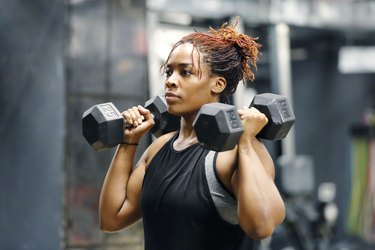
If you've ever stood in front of the dumbbell rack contemplating which exercises were going to maximize your workout time while also sculpting lean muscle from head to toe, allow us to introduce you to your new best fitness friend: full-body dumbbell exercises.
"In real life, you use your full body to do things like carry groceries or lift furniture, so your training should reflect that," says Henry Halse, head trainer at TS Fitness NYC.
Video of the Day
Think about it: When are you using just your biceps to pick up and carry your toddler? And you couldn't climb stairs or run a 5K with only your hamstrings. What's more, full-body exercises are incredibly efficient, meaning you'll recruit more muscles, burn more calories and finish your workout faster.
"Full-body exercises are your best bet if you're short on time," Halse says. "Try to prioritize full-body exercises first in your workout because they require the most energy, coordination and focus."
For the most bang for your buck, incorporate these three exercises into your next strength-training workout.
Tip
Use slightly heavier dumbbells for full-body exercises than you'd use for isolation exercises, like biceps curls, Halse says. "Don't be afraid to push yourself a little and experiment with heavier weight. You might surprise yourself with how much you can lift!"
1. Dumbbell Swing
- Start standing with your feet shoulder-width apart, knees bent slightly, holding a dumbbell in front of you with both hands.
- Keeping your back flat, shoot your hips back and pull the weight between your legs and under your hips. You should feel a gentle stretch in your hamstrings.
- On an exhale, push your hips forward and straighten your legs, swinging the dumbbell up to chest height with control.
- Using the weight's momentum, swing the dumbbell back between your legs and under your hips as you simultaneously sink into your hips and bend your knees.
Tip
"Keep your back flat and heels planted firmly into the ground," Halse says. "Use your hips to thrust the dumbbell into the air, rather than using your lower back." He also recommends using chalk or gloves (if you have them) to help you maintain a solid grip on the dumbbell and ensure it doesn't slip.
2. Dumbbell Thruster
- Start standing with your feet just wider than hip-distance apart, core engaged, with a dumbbell in each hand at your shoulders, palms facing in.
- Keeping your chest tall and core tight, hinge your hips back and down to sink into a squat. Lower until your thighs are parallel with the ground — or as low as you can comfortably squat while maintaining good form.
- Press through all four corners of your feet to return to standing.
- As you straighten your legs, press the dumbbells up over your head. Your upper arms should stay close to your ears.
- Slowly bend your elbows to lower the dumbbells back down to your shoulders with control.
Tip
"Try to keep the dumbbells relaxed on your shoulders when you squat," Halse says. "If you try to hold them above your shoulders your arms will get tired quickly, which will force you to stop sooner."
Unlike with other exercises, don't be afraid to rely on momentum here. "When you come up from the squat, build as much momentum as possible to make the press easier," he says. "Remember that your legs are much stronger than your shoulders."
3. Farmer's Walk
- Hold a dumbbell in each hand (or one on one side). Choose a weight that's heavy enough to challenge you yet light enough that you can maintain good posture while walking.
- Engage your core, pull your shoulder blades down and back and stand tall.
- Take a step forward and begin walking. Walk quickly while still keeping your spine tall, shoulders back and head up.
- Continue walking movement for a specified time or number of steps.
Tip
"Use the heaviest weight you can muster," Halse says. "But be careful when you pick the weights up from the ground. Imagine you're performing a deadlift and keep your back as flat as possible."